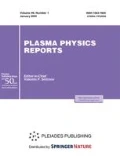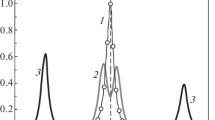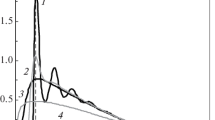Abstract
Results are presented from analytical and numerical studies of the effect of a dc magnetic field on the spectral characteristics of thermal motion of charged particles in an isotropic electrostatic trap. An analytic expression for the spectral density of the shifts of the center of mass of the systems under study is obtained. The analytic expression is verified by numerically simulating ensembles with different numbers of particles interacting via the Coulomb potential in a wide range of parameters.








Similar content being viewed by others
REFERENCES
Photon Correlation and Light Beating Spectroscopy, Ed. by H. Z. Cummins and E. R. Pike (Plenum, New York, 1974).
Ya. I. Frenkel, Kinetic Theory of Liquids (Nauka, Moscow, 1975; Oxford University Press, Oxford, 1976).
R. Balescu, Equilibrium and Nonequilibrium Statistical Mechanics (Wiley Interscience, New York, 1975).
A. A. Ovchinnikov, S. F. Timashev, and A. A. Belyi, Kinetics of Diffusion-Controlled Chemical Processes (Khimiya, Moscow, 1986; Nova Science, Commack, NY, 1989).
O. S. Vaulina, O. F. Petrov, V. E. Fortov, A. G. Khrapak, and S. A. Khrapak, Dusty Plasma: Experiment and Theory (Fizmatlit, Moscow, 2009) [in Russian].
Complex and Dusty Plasmas, Ed. by V. E. Fortov and G. E. Morfill (CRC, Boca Raton, FL, 2010).
Y. P. Raizer, V. I. Kisin, and J. E. Allen, Gas Discharge Physics (Springer, Berlin, 2011).
J. I. Jimenez-Aquino, R. M. Velasco, and F. J. Uribe, Phys. Rev. E 77, 051105 (2008).
L. J. Hou, Z. L. Miskovic, A. Piel, and P. K. Shukla, Phys. Plasmas 16, 053705 (2009).
B. Farokhi, M. Shahmansouri, and P. K. Shukla, Phys. Plasmas 16, 063703 (2009).
O. S. Vaulina, E. A. Lisin, and E. A. Sametov, JETP 125, 976 (2017).
E. A. Sametov, R. A. Timirkhanov, and O. S. Vaulina, Phys. Plasmas 24, 123504 (2017).
O. S. Vaulina and K. G. Adamovich, JETP 106, 955 (2008).
O. S. Vaulina, K. G. Adamovich, O. F. Petrov, and V. E. Fortov, JETP 107, 313 (2008).
O. S. Vaulina, E. A. Lisin, A. V. Gavrikov, O. F. Petrov, and V. E. Fortov, JETP 110, 662 (2010).
O. S. Vaulina and E. A. Lisin, Phys. Plasmas 16, 113702 (2009).
V. E. Fortov, O. F. Petrov, O. S. Vaulina, and K. G. Koss, JETP Lett. 97, 322 (2013).
G. A. Hebner, M. E. Riley, and K. E. Greenberg, Phys. Rev. E 66, 046407 (2002).
O. S. Vaulina and I. E. Drangevski, Phys. Scr. 73, 577 (2006).
M. M. Vasil’ev, L. G. D’yachkov, S. N. Antipov, O. F. Petrov, and V. E. Fortov, JETP Lett. 86, 358 (2007).
L. G. D’yachkov, O. F. Petrov, and V. E. Fortov, Contrib. Plasma Phys. 49, 134 (2009).
V. Yu. Karasev, E. S. Dzlieva, A. Yu. Ivanov, and A. I. Eikhval’d, Phys. Rev. E 74, 066403 (2006).
N. Sato, G. Uchida, and T. Kaneko, Phys. Plasmas 8, 1786 (2001).
R. F. Post, Rev. Mod. Phys. 28, 338 (1956).
L. A. Artsimovich, Controlled Thermonuclear Reactions (Fizmatgiz, Moscow, 1961; Gordon & Breach, New York, 1964).
R. Aymar, P. Barabaschi, and Y. Shimomura, Plasma Phys. Controlled Fusion 44, 519 (2002).
A. V. Timofeev, Plasma Phys. Rep. 33, 890 (2007).
B. P. Cluggish, F. A. Anderegg, R. L. Freeman, J. Gilleland, T. J. Hilsabeck, and R. C. Isler, IEEE Trans. Plasma Sci. 12, 057101 (2005).
N. A. Vorona, A. V. Gavrikov, A. A. Samokhin, V. P. Smirnov, and Yu. S. Khomyakov, Yad. Fiz. Inzhin. 5, 944 (2014).
V. P. Smirnov, A. A. Samokhin, N. A. Vorona, and A. V. Gavrikov, Plasma Phys. Rep. 39, 456 (2013).
V. B. Yuferov, A. M. Egorov, V. O. Il’icheva, S. V. Sharyi, and K. I. Zhivankov, Vopr. At. Nauki Tekh., Ser. Fiz. Radiat. Povrezhd. Radiat. Materialoved. 101, 148 (2013).
Yu. P. Raizer, Gas Discharge Physics (Nauka, Moscow, 1987; Springer-Verlag, Berlin, 1991).
E. A. Lisin and O. S. Vaulina, JETP 115, 947 (2012).
S. Chandrasekhar, Rev. Mod. Phys. 15, 1 (1943).
O. S. Vaulina and E. A. Sametov, JETP 127, 350 (2018).
A. A. Voronov, Theory of Automatic Control (Vysshaya Shkola, Moscow, 1986), Part 2 [in Russian].
A. A. Shchegol’kov, Molodezh. Nauchno-Tekh. Vest. 8, 24 (2013).
O. S. Vaulina, I. I. Lisina, and E. A. Lisin, Plasma Phys. Rep. 44, 270 (2018).
ACKNOWLEDGMENTS
This work was supported by the Russian Science Foundation, grant no. 14-29-00231.
Author information
Authors and Affiliations
Corresponding author
Additional information
Translated by E. Voronova
APPENDIX
APPENDIX
Any solution F(t) to problem (2) and (3) can be represented as the superposition
where  for the function \(\left\langle {x{{{(t)}}^{2}}} \right\rangle \) and
for the function \(\left\langle {x{{{(t)}}^{2}}} \right\rangle \) and  for the function \(\left\langle {x({{t}^{*}})x({{t}^{*}} + t)} \right\rangle \). The coefficient Сi (\(i = 1,2,3,4\)) for these functions can be found from the initial conditions of the problem:
for the function \(\left\langle {x({{t}^{*}})x({{t}^{*}} + t)} \right\rangle \). The coefficient Сi (\(i = 1,2,3,4\)) for these functions can be found from the initial conditions of the problem:  , \(dF\left( 0 \right){\text{/}}dt = 0\),
, \(dF\left( 0 \right){\text{/}}dt = 0\),  , \({{d}^{3}}F\left( 0 \right){\text{/}}d{{t}^{3}} = 0\), where Т0 = 0 for \(\left\langle {x{{{(t)}}^{2}}} \right\rangle \),
, \({{d}^{3}}F\left( 0 \right){\text{/}}d{{t}^{3}} = 0\), where Т0 = 0 for \(\left\langle {x{{{(t)}}^{2}}} \right\rangle \),  for \(\left\langle {x({{t}^{*}})x({{t}^{*}} + t)} \right\rangle \), Т2 = 2T/М for \(\left\langle {x{{{(t)}}^{2}}} \right\rangle \), and Т2 = ‒2T/М for \(\left\langle {x({{t}^{*}})x({{t}^{*}} + t)} \right\rangle \). As a result, we obtain the following set of equations for the coefficients Сi:
for \(\left\langle {x({{t}^{*}})x({{t}^{*}} + t)} \right\rangle \), Т2 = 2T/М for \(\left\langle {x{{{(t)}}^{2}}} \right\rangle \), and Т2 = ‒2T/М for \(\left\langle {x({{t}^{*}})x({{t}^{*}} + t)} \right\rangle \). As a result, we obtain the following set of equations for the coefficients Сi:
Hereinafter, the minus sign refers to the function \(\left\langle {x{{{(t)}}^{2}}} \right\rangle \), while the plus sign refers to the function \(\left\langle {x({{t}^{*}})x({{t}^{*}} + t)} \right\rangle \). Thus, for the coefficients Сi, we have




Using formulas (5a) and (5b) for the eigenfrequencies λi and assuming that  and \({{\nu }^{2}} - {{D}_{1}}^{2}{\text{/}}2 \ll 2{{\omega }_{{1,2}}}\) (where \({{\omega }_{1}} = {{(\Psi _{1}^{2} + \Omega _{1}^{2})}^{{1/2}}}\) and \({{\omega }_{2}} = {{(\Psi _{2}^{2} + \Omega _{2}^{2})}^{{1/2}}}\)), we represent formulas (6)–(9) as
and \({{\nu }^{2}} - {{D}_{1}}^{2}{\text{/}}2 \ll 2{{\omega }_{{1,2}}}\) (where \({{\omega }_{1}} = {{(\Psi _{1}^{2} + \Omega _{1}^{2})}^{{1/2}}}\) and \({{\omega }_{2}} = {{(\Psi _{2}^{2} + \Omega _{2}^{2})}^{{1/2}}}\)), we represent formulas (6)–(9) as




Here,  and \({{B}_{2}}\, = \,\sqrt 2 (\omega _{1}^{2}\, - \,\omega _{t}^{2}){\text{/}}\)
and \({{B}_{2}}\, = \,\sqrt 2 (\omega _{1}^{2}\, - \,\omega _{t}^{2}){\text{/}}\) .
.
Note that the above-mentioned conditions \(D_{1}^{2} \ll \) and \({{\nu }^{2}} - D_{1}^{2}{\text{/}}2 \ll 2{{\omega }_{{1,2}}}\) are satisfied when \({{({{\Psi }_{{1,2}}})}^{2}} \ll {{({{\Omega }_{{1,2}}})}^{2}}\).
and \({{\nu }^{2}} - D_{1}^{2}{\text{/}}2 \ll 2{{\omega }_{{1,2}}}\) are satisfied when \({{({{\Psi }_{{1,2}}})}^{2}} \ll {{({{\Omega }_{{1,2}}})}^{2}}\).
Rights and permissions
About this article
Cite this article
Vaulina, O.S., Sametov, E.A. Effect of Magnetic Field on the Spectral Characteristics of Thermal Motion of Charged Particles in an Isotropic Trap. Plasma Phys. Rep. 45, 237–245 (2019). https://doi.org/10.1134/S1063780X19020120
Received:
Revised:
Accepted:
Published:
Issue Date:
DOI: https://doi.org/10.1134/S1063780X19020120




